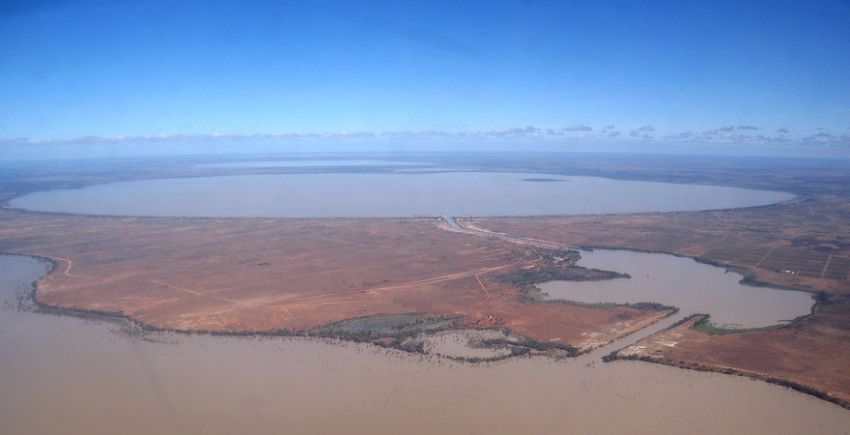
The Murray Darling Basin (MDB), Australia’s largest river system, is home to more than 40 First Nations nations, provides drinking water for 3.5 million people and is essential for agriculture and tourism. Its sustainability is vital.
The approach of parties seeking to be elected to the MDB and its water distribution plan needs to weighed up because, while La Niña means rivers are flowing and some floodplains have been inundated, too much water is being allocated to irrigators. There is excessive extraction of water through floodplain harvesting, the survival of Menindee Lakes is threatened and public trust in the integrity of water management has sunk to an all-time low.
The underlying problem — the climate change crisis — also remains.
Agriculture Minister David Littleproud claims that the interstate water-sharing deal — the Murray Darling Basin Plan (MDBP) — is dead. But the plan, which returns 450 gigalitres of water to ensure the viability of rivers and supply of four Eastern states, nonetheless continues, as it is law.
Federal Water Minister Keith Pitt continues to rule out buying back water licences from willing sellers to meet the plan’s targets.
The Nationals are also pushing to axe the plan to reclaim the 450 gigalitres from efficiency projects, to outlaw more federal buy-backs and extend the deadline for water-saving projects beyond 2024.
Water in the MDB is managed under agreement between the states and the federal government. The Nationals’ bid to undermine the interstate water sharing agreement is being resisted by South Australian Senators, who strongly support the MDBP being implemented in full and on time.
Labor water spokesperson Terri Butler supports voluntary buy-backs, however Victorian water minister Lisa Neville continues to speak out strongly against buy-backs, under pressure from Southern basin irrigators.
The MDB has suffered because of the over-extraction of water; it needs water allocations to be reduced if the damage is to be repaired. Water buy-backs would minimise water trading, by putting it back into the rivers and river communities where it is needed.
The Labor Party’s MDB five-point plan claims it will “restore science, integrity and environmental focus” with funding to CSIRO, backing sustainable yields and supporting for accountability measures.
Labor has promised to: commit $26 million to establish a National Water Commission to drive ongoing water reform, and future-proof Australia’s water resources; and broaden the National Water Grid Fund investment policy “to allow funding for a broader range of projects, including for essential town water supplies in regional and remote communities”.
The only water policy released by the Coalition has been their controversial and costly dam building projects in key electorates.
Nationals leader Barnaby Joyce has been promising Queensland a new 61,000 gigalitre Hells Gate dam, and to create a new irrigation region. The government abolished its own National Water Grid Advisory Body before promising $5.6 billion for this new dam.
But an additional obstacle to building new dams as a supposed solution to water scarcity is that licences must be purchased for any water extracted from the MDB system, and it is already seriously over allocated.
Hells Gate water, in central Queensland, could potentially be the country’s most expensive water, pricing it beyond the reach of all but the most profitable irrigation farmers. No business case has been mounted.
The Nationals also failed to mount business cases for their other dam building promises in Dungowan, Wyangala and Mole River in New South Wales.
Labor has promised to reinstate and broaden the remit of the National Water Grid Fund. It accepts the Productivity Commission’s recommendation that the fund’s investment policy should not prioritise one sector or class of water user, nor be limited to providing water for primary industry.
The Greens’ water policy has a strong focus on downstream users. Senator Sarah Hanson Young said the promise of 450 gigalitres to the South Australia “cannot be delivered without restoring voluntary water buybacks”. This is critical, she said, to ensure the longevity of the Murray system, and those who rely on it.
An alliance of small farmers, water users and First Nations peoples, the Lifeblood Alliance, is campaigning for the MDBP to be fully implemented.
The Alliance said: “Labor’s commitment to deliver 450 gigalitres of water is vital if we are to meet the targets of the plan, which, according to the science, is the bare minimum needed to save rivers, wetlands and sustain river communities”.
It wants the National Water Commission re-established, its data and modelling published, more funds to research and more to monitor compliance.
It is also calling for a long overdue reform — to increase First Nations people’s ownership of water. Currently, they hold less than 0.2% of MDB water. Whichever party forms government after May 21, state and federal water ministers must renew the MDA, the Alliance concluded.